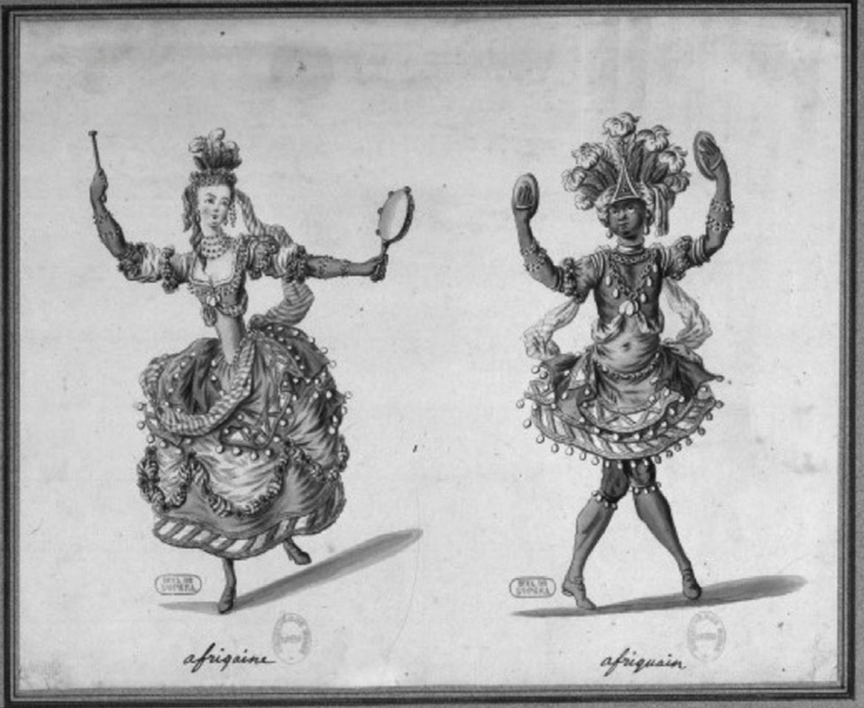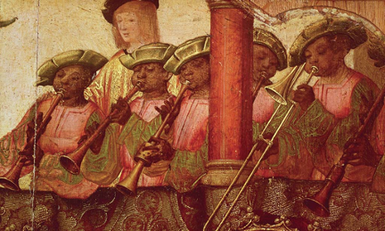Bringing Them into the Picture: Considering Black Musicians in Early Modern European Music History
Par Kiran Steele
Prevalent narratives on Western European art music history feature White composers almost exclusively and neglect musicians of colour, especially Black musicians. The inherent whiteness of the canon has been present since its creation in the late-nineteenth century, and while this fact has been acknowledged by several musicologists (e.g., Walker 2020, 10-12), practical solutions to address it are lacking. As a person of colour studying European classical music in an undergraduate university program, I often wonder why classrooms and scholarly publications overlook Black musicians. The lives of many such musicians in Europe during the early modern period reveal complex relationships with culture and music specifically that are worth exploring. Fortunately, several scholars have published accessible articles and book chapters on Black musicians during the early modern period that can expand traditional educational offerings. This article will summarize the contents of two such sources and explain how teachers can incorporate them into their classrooms. In doing so, I assert that Black perspectives must be considered if educators want to offer nuanced perspectives on European music history.
The work required to include Black musicians
Numerous musicologists and educators have advocated for the inclusion of diverse racial voices in music instruction. For instance, Deborah Bradley (2017) has discussed the underlying whiteness of music education curricula, the challenges associated with reforming the entire system, solutions teachers can employ, and schools in Canada and the United States that have meaningfully reformed their curricula. She states the following:
|
Music schools need to understand the racial assumptions that underlie classical music studies in higher education, as well as how pervasively those assumptions manifest themselves in our behaviours, our educational processes, and, education products. (Bradley 2017, 208)
|
|
To accomplish this goal, however, educators need to reflect on what musics and composers they teach, consider how they can diversify materials, and take steps to amplify the voices, music, and activities of Black musicians. The experiences of Black musicians in early modern Europe offer potential to alter standard narratives by their very inclusion. The following two articles present ideas that teachers can use to move in this direction.
|
Black musicians in early modern Germany and France
Arne Spohr’s “‘Mohr Und Trompeter’: Blackness and Social Status in Early Modern Germany” discusses Black court musicians in Germany from the sixteenth to the eighteenth centuries (Spohr 2019). Spohr’s main criticism focuses on scholars who have suggested that Black German court musicians had a lot of autonomy, that they experienced minimal discrimination due to their skin colour, and that White Germans did not try to make them an “Other.” He asserts that, in studying Black musicians...
|
...the category of blackness cannot be neglected, since its perception in early modern German society was indeed connected to social status... the social position of the black trumpeters and drummers was far more fragile than that of their white colleagues (Spoor 2019, 617).
|
|
Drawing on a variety of historical documents and descriptions, Spohr explains how early modern Germans regularly exoticized Black people and associated them with “paganism and sin” (Spohr 2019, 620). He also describes how Black musicians depended on their patrons for their relative freedom and risked getting attacked physically and verbally in public, since the nobility could not guarantee their safety outside of the courts (Spohr 2019, 629-630, 639). Black court musicians in Germany experienced numerous challenges despite their higher status compared to non-courtly Black individuals (Spohr 2019, 631). Skin colour thus contributed significantly to how one was perceived.
In introducing this article to students, teachers can address the fact that Black musicians did not have an entirely positive experience while working for the court, as multiple factors determined how they were regarded by mainstream German society. With this insight, teachers can encourage students to make connections to the modern world by considering how humanity tends to think about blackness and how it is not only tied to social context but also influenced musical practices in early modern Germany. In doing so, teachers can disrupt, at least in part, the dominant historical narrative and its continuity in modern society. |
 Figure 3: Costume designs by Louis-René Boquet for the
Figure 3: Costume designs by Louis-René Boquet for the production Africaine et Africain (Bloechl 2014, 92). Boquet,
Louis-René, “Africaine et Africain,” c. 1775.
In a similar manner to Spohr, Olivia Bloechl’s “Race, Empire, and Early Music” argues that race played a significant role in early music history. Bloechl remarks that “...the idea of early music as inherently European identifies it implicitly with whiteness and with lighter-skinned people of European descent” (Bloechl 2014, 104). She supports her argument by considering a handful of costume designs for French ballet and operatic productions in the eighteenth century. Bloechl investigates the use of blackface by White performers, how often Black performers were cast, and what operatic roles Black and White performers typically played. Her analysis reveals that Black and White actors were often cast in roles according to their race (i.e., higher-status characters for White people and lower-status characters for Black people). Furthermore, changes in the costume designs over the century mirrored shifts in racial thought by the French and demonstrated that they did indeed perceive races differently. As in Germany, French views on Black people were often reductive, and these views informed their musical and theatrical practices.
In the classroom, students can analyze the photos provided by Bloechl to identify changes in the costume designs and note the features used by the French to stereotype Black people. From there, the teacher can lead guided discussions on how race played a factor in French society and encourage students to reinforce the connections described above.
Conclusion
In summary, the articles by Spohr and Bloechl reveal the presence and activities of Black musicians in early modern Europe and show the impact of race on their lives. The research is thorough and the frameworks are nuanced, giving educators two excellent sources for creating more diversity in the classroom. Students who read excerpts of these two publications, or the publications in their entirety, will gain a broader perspective on race in early music history. In turn, they will help disrupt the whiteness of the canon and deepen our understanding of the agency of Black musicians in the early modern period and beyond.
Bibliography
BLOECHL, Olivia A. 2014. “Race, Empire, and Early Music.” In Rethinking Difference in Musical Scholarship, edited by Olivia A. Bloechl, Melanie Lowe, and Jeffrey Kallberg. Cambridge, UK: Cambridge University Press, p. 77-107.
BRADLEY, Deborah. 2017. “Standing in the Shadows of Mozart: Music Education, World Music, and Curricular Change.” In College Music Curricula for a New Century, edited by Robin D. Moore. New York: Oxford University Press, p. 205-222. https://doi.org/10.1093/acprof:oso/9780190658397.003.0011.
KOZA, Julia E. 2010. “Listening for Whiteness: Hearing Racial Politics in Undergraduate School Music.” In Music Education for Changing Times: Guiding Visions for Practice, edited by J. Terry Gates and Thomas A. Regelski. Dordrecht, Heidelberg, London, and New York: Springer, p. 85-95.
SPOHR, Arne. 2019. “‘Mohr Und Trompeter’: Blackness and Social Status in Early Modern Germany.” Journal of the American Musicological Society, vol. 72, no. 3: 613-63. https://doi.org/10.1525/jams.2019.72.3.613.
WALKER, Margaret. 2020. “Towards a Decolonized Music History Curriculum.” Journal of Music History Pedagogy, Special Issue: Decolonization, vol. 10, no. 1: 1-19.
BRADLEY, Deborah. 2017. “Standing in the Shadows of Mozart: Music Education, World Music, and Curricular Change.” In College Music Curricula for a New Century, edited by Robin D. Moore. New York: Oxford University Press, p. 205-222. https://doi.org/10.1093/acprof:oso/9780190658397.003.0011.
KOZA, Julia E. 2010. “Listening for Whiteness: Hearing Racial Politics in Undergraduate School Music.” In Music Education for Changing Times: Guiding Visions for Practice, edited by J. Terry Gates and Thomas A. Regelski. Dordrecht, Heidelberg, London, and New York: Springer, p. 85-95.
SPOHR, Arne. 2019. “‘Mohr Und Trompeter’: Blackness and Social Status in Early Modern Germany.” Journal of the American Musicological Society, vol. 72, no. 3: 613-63. https://doi.org/10.1525/jams.2019.72.3.613.
WALKER, Margaret. 2020. “Towards a Decolonized Music History Curriculum.” Journal of Music History Pedagogy, Special Issue: Decolonization, vol. 10, no. 1: 1-19.



